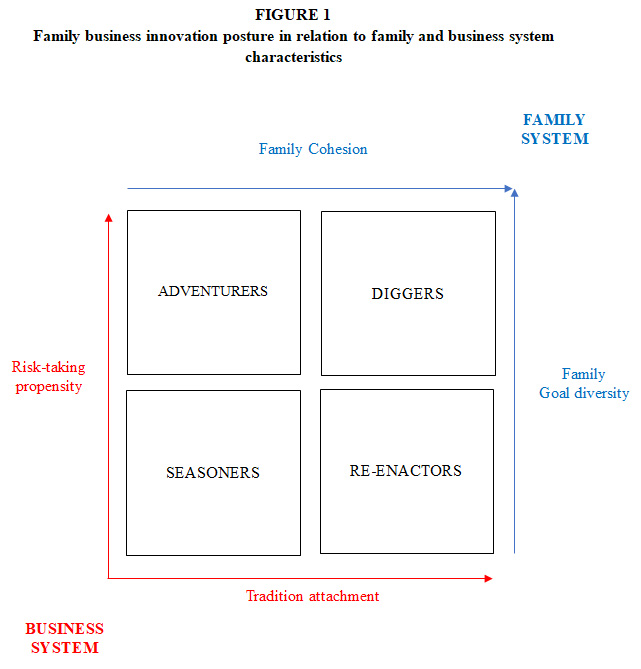Unlocking the Innovation Potential of Family Firms: An Assessment Tool

When it comes to innovation, family firms often are trapped in an “ability–willingness paradox”: the superior ability to innovate is unrealized because of fear of innovation. Our research1 suggests that the family itself holds the key to solving this paradox and unlocking innovative potential.
Family firms’ reluctance to innovate is surprising because it clashes with a long-term orientation, which should otherwise encourage the family to focus on new technologies to ensure a sustainable future across generations. Yet family owners and managers fear losing control, undermining the family reputation, or compromising their socioemotional wealth (i.e., the pool of non-financial benefits associated with family ownership and control). Thus, it is necessary that family firms strike a delicate balance between the business and the family. From the business perspective, they need to ensure they take enough risks but still preserve traditions. At the same time, they need to leverage goal diversity and cohesion within the family. Navigating these tensions is certainly a challenging task. Here, we provide an assessment tool that family businesses can use to check and ensure a fit between the business and the family systems so as to fully unlock the innovation potential.
The ability-willingness innovation paradox
Family firms can be much more innovative than non-family firms. Because their leadership is in the hands of a small number of owners, family businesses don't need to engage in internal political dynamics or convince layers of management when they want to innovate. Moreover, family members who aim to transfer their business to next generations are more prone to engage in long-term oriented investments. Once the leader has been convinced about the opportunity of an innovation, the low level of bureaucracy in family firms allows for rapid implementation.
While the ability is high, family firms are often reluctant to innovate. They have a variety of financial and non-financial goals that influence their willingness to engage in innovation. For example, if the owners want to transfer the business to next generation they may avoid uncertain investments that could jeopardize the firm's survival long term. On the other hand, wanting to keep the business in the family can also act as an incentive because innovation is generally seen as necessary to keep the business thriving over time (unless the business operates in a highly protected niche).
Therefore, in comparison to their non-family counterparts, family businesses are characterized by higher discretion to engage in innovation (ability) combined with lower disposition to do so (willingness). Research has labeled this tension as the “ability-willingness paradox."2
The business system perspective
The family business innovation posture flows from the strategic orientation that the family imprints on the family business, shaping the firm’s innovation climate, philosophy, and practices. You can assess your family business posture by looking at two core dimensions: risk-taking propensity and tradition attachment.
Risk-taking propensity is the tendency of a family business to engage in behaviors that have uncertain outcomes. A family business with high risk-taking propensity is more prone to gamble precious resources on new ideas, taking steps into the unknown with the aim of reaching higher returns. Conversely, family businesses with low risk-taking propensity are characterized by sticking to more ordinary paths, consciously and smoothly moving forward in a step-by-step manner.
Tradition attachment refers to how strongly the family firm clings to its past and wants to preserve it. When family businesses share and are committed to shielding their legacy across the generations with intangible resources (such as histories, stories, rites and events) or tangible objects (books, portraits, museums and archives) and celebrate their ancestors’ past behavior, they are considered highly attached to their tradition. Conversely, family businesses with low traditional attachment consider the past as a burden; these firms constantly seek to evolve by discarding the old to make room for the new.
The combination of the characteristics of the business system in terms of risk-taking propensity and tradition attachment leads to a framework of four representative family business innovation postures. Figure 1 depicts the framework and provides examples of family businesses adopting each posture. As you think about the innovation posture in your family business, you may benefit from reflecting on the characteristics of your business system.

Seasoner: your family business is oriented toward changing the meaning of current-state activity in contrast with the past, without bearing too much risk. So, you reshape current resources, while maintaining the inner nature, to develop something “tastier.”
Re-enactor: in your family firm you innovate close to the status quo. Such historical philosophy leads to searching in your family business memories and inherited values to inspire innovation.
Digger: your family business boosts the intertwining of unique traditional organizational resources and capabilities, based on your legacy and historical roots, with contemporary ones in order to innovate.
Adventurer: in your family firm you innovate beyond the trends, always challenging the status quo and leveraging accumulated expertise to develop something distant from current and past activities.
In all the four circumstances the family business can be very innovative, but each type innovates differently. A problem is that the innovation posture defined at the business level often does not fit the family system.
Assess your family business innovation posture
To solve the ability-willingness paradox, looking exclusively at the business system is not enough. It is also necessary to ensure consistency between the business system and the family system. In other words, innovation is best served when the innovation posture of the family firm is consistent with the characteristics of the family. Two dimensions of the family system emerge as crucial: goal diversity and cohesion.
Family goal diversity. The goals pursued by family members in the family business might diverge or converge. The misalignment of goals is not necessarily negative, since it can trigger individual interests beneficial to the family firm, specifically in innovation initiatives. Conversely, when family members are aligned toward the same target(s), such misalignment could be positive since harmony smooths innovation processes, but it could also be detrimental if it discourages divergent thinking.
Family cohesion refers to the emotional bonding that family members have toward one another. Highly cohesive families feel altruism and a greater sense of belonging, which can encourage family members to pursue innovative initiatives. However, high family cohesion could also lead to excessive inward perspective and discourage openness. Low family cohesion can be negative if quarreling stifles the unity needed to ideate and implement innovative ideas, or it might be positive if it spurs novel ideas through creative conflict resolution.
Assessment tool helps unlock innovation potential
To fully unlock your family business’s innovation potential, the innovation posture adopted by the business should have good fit with the family’s dimensions of goal diversity and cohesion. So, what is your family business innovation posture? Are you ensuring a close fit between the business and the family systems so as to solve the family business innovation paradox?
We provide a short list of questions below that allow you to look at where you currently stand along the family and business systems in your family firm and enable you to see what position your family business occupies in the framework. The first step is to understand the innovation posture that your family business is adopting. For each of the statements in Table 1 – business system, indicate the likelihood that your family business would engage in the described activity or behavior:
TABLE 1- Assessment tool for business and family system
For each item provide a point from 0 to 5
Scores for the business system:
Risk taking propensity >7.5, tradition attachment >7.5 = Digger
Risk taking propensity <7.5, tradition attachment >7.5 = Re-enactor
Risk taking propensity <7.5, tradition attachment <7.5 = Seasoner
Risk taking propensity >7.5, tradition attachment <7.5 = Adventurer
Scores for the family system:
Family goal diversity >7.5, Family cohesion >7.5 = Digger
Family goal diversity <7.5, Family cohesion >7.5= Re-enactor
Family goal diversity <7.5, Family cohesion <7.5 = Seasoner
Family goal diversity >7.5, Family cohesion <7.5 = Adventurer
The second step requires you to understand the characteristics of the family system. For each of the statements in Table 1 – family system, indicate the likelihood that your family would engage in the described activity or behavior.
Does the innovation posture identified in the first step match that suggested in the second step? If the postures you have identified in steps one and two match, then your business and family systems characteristics are consistent, and the innovation posture adopted allows you to fully unlock your family firm’s innovation potential. If not, we provide some guidelines to take action on the drivers in order to ensure closer fit.
Re-establishing a fit between the family and business systems
One of the most critical dimensions of change for family firms, involving both the family and the business systems, is inter-generational leadership transitions. Such change is likely to change a family's goal diversity and cohesion, while also affecting risk-taking propensity and tradition attachment. Therefore, inter-generational leadership transitions are a significant opportunity for family firms to ensure fit between the family and business systems, by potentially adopting an alternative family business innovation posture or tuning the drivers toward a new configuration that unlocks innovation potential. Inter-generational leadership transitions are just one of the many opportunities to boost change in the business and family systems. Family changes can be exploited as opportunities for ensuring a novel fit in your family business. These changes might include creating a new division, a new family member joining the business, or when a younger family member marries and creates of a new family system to interact with the business and with the original family.
Conclusion
Family businesses are often stigmatized as more conservative and reluctant to innovate in comparison with their non-family counterparts. Yet, in reality, most innovative firms worldwide are family owned and managed. Using the framework discussed here and the tool offered, you can conduct an assessment of the relationships between the family and business systems in relation to innovation, and identify your family business innovation postures. This tool can help you assess the fit between the posture adopted at the business and the family system levels, providing guidance on how to unlock your family business innovation potential.
Acknowledgements
We would like to thank Joseph J. Astrachan and Torsten Pieper for their excellent feedback on earlier versions of this article.
References
1. Rondi, E., De Massis, A., & Kotlar, J. (2018). Unlocking innovation potential: A typology of family business innovation postures and the critical role of the family system. Journal of Family Business Strategy, in press. https://doi.org/10.1016/j.jfbs.2017.12.001
2. Chrisman, J.J., Chua, J.H., De Massis, A., Frattini, F., & Wright, M. (2015). The ability and willingness paradox in family firm innovation. Journal of Product Innovation Management, 32(3), 310-318.
Additional Search Terms: innovation, family business change, family business innovation, family business strategy, family business planning

Assistant Professor / Department of Management / Università degli Studi di Bergamo
View Profile

Professor of Entrepreneurship & Family Business / D’Annunzio University of Chieti-Pescara, IMD Business School and Lancaster University
View Profile

Associate Professor of Strategy, Innovation & Family Business / School of Management / Politecnico di Milano
View Profile





